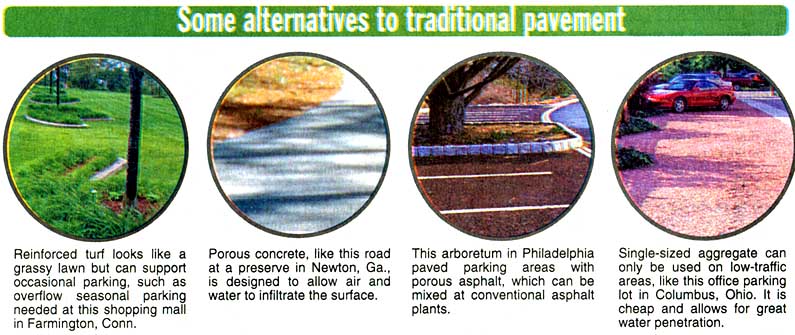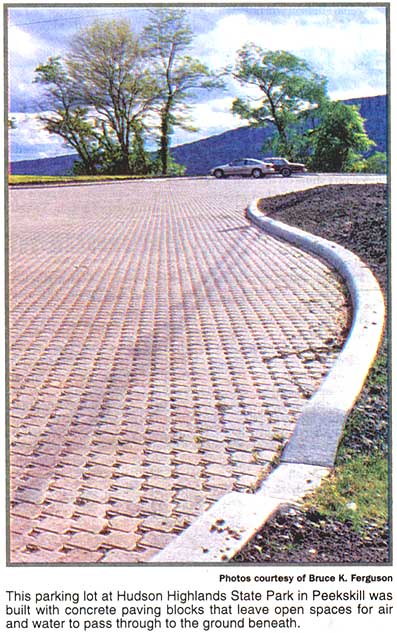
August 14, 2005
Other options allowing water seepage better for the environment

DAN SHAPLEY, ENVIRONMENT EDITOR

 Asphalt is path to pollution
Asphalt is path to pollution
By Bruce K. Ferguson
For the Poughkeepsie Journal

Other options allowing water seepage better for the environment

DAN SHAPLEY, ENVIRONMENT EDITOR

 Asphalt is path to pollution
Asphalt is path to pollution
By Bruce K. Ferguson
For the Poughkeepsie Journal
The causes of many of the environmental problems people witness in their daily lives are underneath their feet. So are the solutions.
As the population grows and urban development alters the natural landscape, the percentage of the land covered by impervious surfaces — buildings and pavements — increases. The increase triggers a chain of events that ultimately affects air and water. But today there are alternatives available that can facilitate a more natural water cycle even in heavily developed areas.
Impervious roofs and pavements seal the soil surface, preventing rain water from percolating into the ground.
During dry summers, stream flows decline because there is less groundwater feeding streams. Some cities that rely on wells or surface water face drinking water shortages.
Instead of percolating into the ground, rain runs off pavement into storm drains and directly into streams. During storms, floods peak into destructive bursts. Stream channels erode and water runs thick with sediments, eliminating some aquatic habitats. Oil and heavy metals from automobiles flush directly into streams. In some cities, the flood waters get into sewers, causing them to overflow and flush raw sewage into streams.
Materials collect heat
Impervious construction materials collect solar heat in their dense mass. When the heat is released, it raises air temperatures and increases energy use.
Impervious pavements deprive tree roots of aeration, eliminating the "urban forest" and the canopy shade that would otherwise moderate urban climate. Because impervious surfaces displace living vegetation, they reduce ecological productivity and interrupt atmospheric carbon cycling.
In the contiguous 48 states, 43,000 square miles of earth are covered with impervious surfaces — an area nearly the size of Ohio. Continuing development adds almost 400 square miles every year.
Two thirds of that area is pavement, and simple new construction technologies offer the promise of restoring a large part of the urban environment.
"Porous" pavements are those made with built-in spaces that let water and air pass through. Although some porous paving materials appear nearly indistinguishable from nonporous materials, their environmental effects are qualitatively different. Recently, an eight-year-long research project concluded with the publication of this technology's first comprehensive overview. This new field is now clearly defined, organized, and accessible.
Porous pavements capture the heavy metals that fall on them, preventing them from washing downstream and accumulating in the environment. Instead, toxic chemicals are caught in the pavement's voids, and naturally occurring micro-organisms digest car oils, leaving little but carbon dioxide and water. The oil ceases to exist as a pollutant.
Rain infiltrates through the pavement, and in many cases, into the underlying soil, reducing the volume of water flushing into streams and restoring its natural flow into underground reserves.
Porous pavements give urban trees the rooting space they need to grow to full size. This is a revolutionary new way to integrate healthy ecology and thriving cities: living tree canopy above, the city's traffic on the ground, and living tree roots below.

Cost is usually less
The cost of porous pavement, with its built-in stormwater management, is usually less than that of an impervious pavement with a separate stormwater management facility somewhere downstream. Installation of porous pavements is not more difficult than that of dense pavements, but it is different.
To date, porous pavements constitute only a minute fraction of the paving done each year in the United States. But their rate of growth, on a percentage basis, is very high, primarily because of public concern about — and legal requirements for — stormwater management.
In growing suburbs, porous pavements protect pristine watersheds. In old town centers, redevelopment and reconstruction are opportunities for environmental rehabilitation simultaneously with urban renewal. Porous pavements could be the most significant development in the urban environment since the invention of the automobile. By paying appropriate attention to the materials on which we walk and drive daily, we can replenish renewable resources, restore regenerative processes, and produce cleaner, healthier, safer, more sustainable cities in which to live.
Bruce K. Ferguson is the director of the University of Georgia School of Environmental Design, and the author of "Porous Pavements" (CRC Press, 2005).
| Watershed Home | Media Menu |